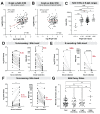High SARS-CoV-2 Seroprevalence and Rapid Neutralizing Antibody Decline among Agricultural Workers in Rural Guatemala, June 2020-March 2021
- PMID: 35891324
- PMCID: PMC9323551
- DOI: 10.3390/vaccines10071160
High SARS-CoV-2 Seroprevalence and Rapid Neutralizing Antibody Decline among Agricultural Workers in Rural Guatemala, June 2020-March 2021
Abstract
Essential agricultural workers work under occupational conditions that may increase the risk of SARS-CoV-2 exposure and transmission. Data from an agricultural worker cohort in Guatemala, and anti-SARS-CoV-2 nucleocapsid IgG (anti-N IgG) testing were used to estimate past infections and analyze risk factors associated with seropositivity at enrollment and association with SARS-CoV-2 infection. The stability of neutralizing antibody (NAb) responses were assessed in a subset of participants. The adjusted relative risk (aRR) for seroprevalence at enrollment was estimated accounting for correlations within worksites. At enrollment, 616 (46.2%) of 1334 (93.2%) participants had anti-N IgG results indicating prior SARS-CoV-2 infection. A cough ≤ 10 days prior to enrollment (aRR = 1.28, 95% CI: 1.13−1.46) and working as a packer (aRR = 2.00, 95% CI: 1.67−2.38) or packing manager within the plants (aRR = 1.82, 95% CI: 1.36−2.43) were associated with increased risk of seropositivity. COVID-19 incidence density among seronegative workers was 2.3/100 Person-Years (P-Y), higher than seropositive workers (0.4/100 P-Y). Most workers with follow-up NAb testing (65/77, 84%) exhibited a 95% average decrease in NAb titers in <6 months. While participants seropositive at baseline were less likely to experience a symptomatic SARS-CoV-2 infection during follow-up, NAb titers rapidly waned, underscoring the need for multipronged COVID-19 prevention strategies in the workplace, including vaccination.
Keywords: COVID-19; Guatemala; SARS-CoV-2; agricultural workers; cohort; seroprevalence.
Conflict of interest statement
D.O. receives grant funding from Roche and Sanofi Pasteur. M.M.L. receives funding from Roche. E.J.A. receives grant funding from Pfizer and is a DSMB member for Curevac and Inovio. J.D.B. and K.L. receive grant research support from Roche Diagnostics. K.M.E. receives grant funding from NIH and CDC, is a consultant to Bionet and IBM, is a member of Data Safety and Monitoring Committees for Sanofi, X-4 Pharma, Seqirus, Moderna, Pfizer, Merck, and Roche.
Figures


References
Grants and funding
LinkOut - more resources
Full Text Sources
Miscellaneous

